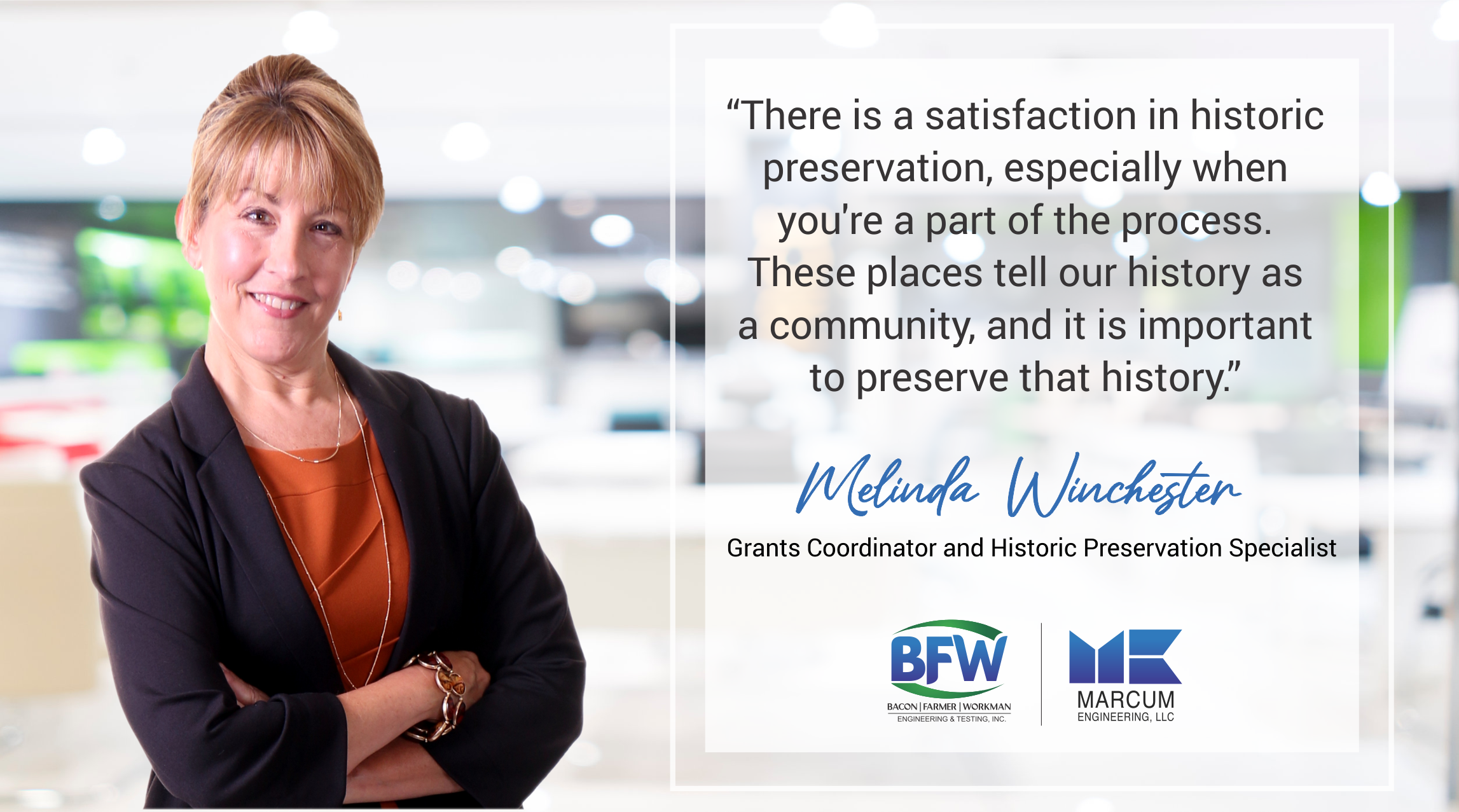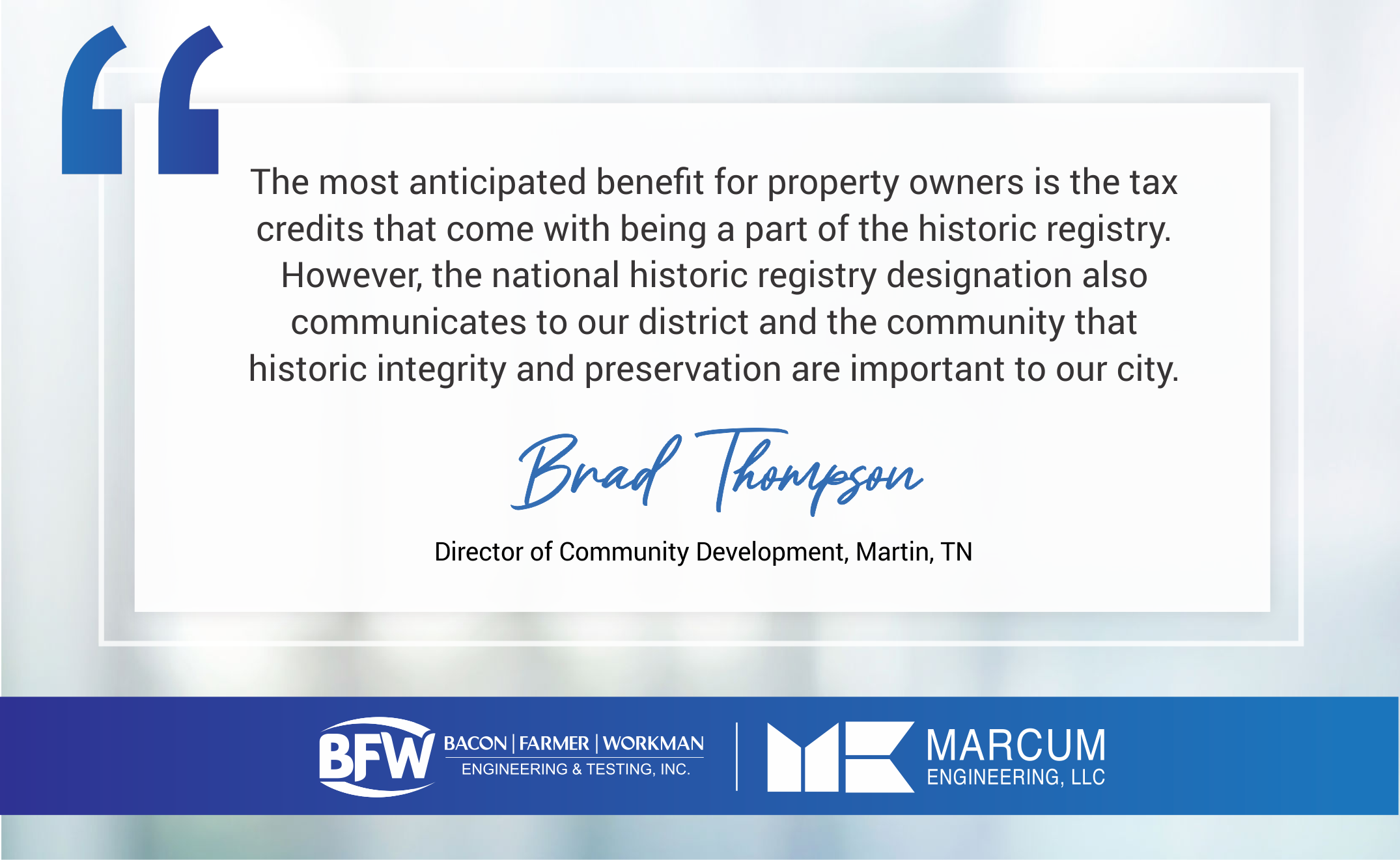When you think of engineering, you might think new. As in, we’re the conceivers of everything new and shiny in this world, whether it’s a recent Lego set or a cutting-edge example of modern architecture in the form of a brand-new skyscraper.
While we respect the new, we make sure to appreciate the old just as well. After all, our past informs our future. Without it, where would we be? We understand the balance between old and new; we feel compelled to respect what’s old while keeping our communities safe and modern.
That’s where people like Melinda Winchester, Grants Coordinator and Historic Preservation Specialist, come in. We talked to her about two aspects of her role: grant writing and historic preservation. At the end of the day, both serve to accomplish the same thing; to bring attention and funds to specific elements of a community, elements that would very much appreciate the awareness.
Grant Writing Obtains Funds to Improve Our Communities
Ask any community organizer what matters most, and they’d probably tell you that it’s money. After all, ideas are cheap, even the great ones. It’s obtaining funds that is the hard part. City budgets generally do a good job of allocating funds to specific parts of a community on an as-needed basis, but there are a few points even Mike Gunn, Fulton City (KY) Manager, admits to needing some extra advocacy.
“Regardless of the source of funding, accessing grant funds is an excellent way for municipalities to further develop relationships and improve the community they serve. Grants that bring in funding for citywide projects are ways to fund projects that would not be funded normally.” explains Mike.
“This kind of funding is imperative to the growth and expansion of a municipality; without it, we’d find our communities out of balance. It’s hard to fund infrastructure improvements internally, especially when there are more pressing things which demand more money and attention from the city, so it’s important to focus on grants when trying to fund these types of improvements.”
It seems to be city-wide, there’s always going to be something which demands the time and attention of the city budget. That’s the reality of the complexity of city management. However, grants allow us to obtain the funds to make proactive improvements to our communities.
We Collaborate with Communities to Fund Positive Change
Melinda has been hard at work with Mike to do just that. “I have been working with Mike Gunn on the development of several grants and project administration. Our collaborative efforts are producing positive results for several of their infrastructure projects and their core historic downtown.”
Mike is particularly proud of their latest work. “With our latest application for funding, we hope to be able to replace an aging natural gas system to make it safer.”
Through grant funding, the city of Fulton will be able to modernize its natural gas system. The system in place is obsolete but replacing it would be a hard sell since it’s still workable. Through outside funding, Mike can bring his community a proactive solution that benefits everyone and does so before there’s an actual problem.
You Have to Find the Funds; That’s Where We Come In
Mike admits, he would have struggled to find the resources to take on grant writing internally. “A firm like BFW/Marcum, especially rockstars like Melinda Winchester, are essential to city management. We would not be able to fund staff to perform grant writing for the city otherwise. We simply do not have the staff to research and prepare or administer grants.”

“BFW/Marcum has the vision to expand beyond engineering and assist our clients with grant coordination,” explains Melinda. “We have established many relationships and built trust with our cities, so the opportunity to help them at this level was an added benefit. Now that we have been providing this new opportunity, we feel it’s a great way to honor the communities we’ve already been serving.”
Historic Preservation Honors Our Past
Speaking of honoring, historic preservation is an important part of what gives a city character, a sense of community, and its history. One way of acknowledging this history is by preserving the unique craftsmanship of historic buildings and protecting our environment by limiting the amount of materials being placed into landfills by demolition.
Programs have been established at the state and federal level to help incentivize municipalities and property owners to consider preservation. Our job is to identify these opportunities and programs for our communities and guide them through the process.
Preservation Makes Cents
Melinda has a deep connection with preservation. She has been helping communities and property owners for over twenty years and as the owner of a historic property, she appreciates the beauty of timeless architecture. She understands the economic benefits that historic preservation affords a city.
“There is a satisfaction in historic preservation, especially when you’re a part of the process. These places tell our history as a community, and it is important to preserve that history. Not only that, but the cities and communities who take the time and commitment to preserve their heritage, show a commitment to their citizens, and to visitors about the importance of that story.

Yet, the benefits don’t stop there. There are financial benefits as well; there are people who want to come into these beautiful, historic towns like Martin, TN and appreciate the past. They want a destination which tells a story. It is an economic driver for tourism, and an effective one.”
Citizens and Leaders are the Stewards of Our Heritage
Brad Thompson, Director of Community Development in Martin, Tennessee, has seen the effect that widespread preservation has on a city, too. “Melinda worked with us to offer her expertise in updating our historic housing and commercial building surveys, and to review our current design review and guidelines.”
Melinda and Brad’s most ambitious project is the application of the Downtown Martin Commercial District for admittance into the National Register of Historic Places. While being part of this registry brings with it nationwide prestige (and more, farther-reaching tourism), it also brings a very practical benefit to the residents of historic properties in Martin, TN.
“The most anticipated benefit for property owners is the tax credits that come with being a part of the historic registry. However, the national historic registry designation also communicates to our district and the community that historic integrity and preservation are important to our city.” said Thompson.

Let’s Keep the Character
We asked Melinda to try and put her finger on the crossroads of engineering and preservation. Where do they meet?
“Historic Preservation and engineering go hand in hand, especially when we are commissioned to work on a historic structure. These structures were not built with the modern conveniences of HVAC, new electrical, new plumbing, lighting, etc. in mind, for the simple reason these technologies did not yet exist.
I help with ensuring that, along with our engineers, we respect the historic character of the building. If the client is utilizing the historic tax credits I can prepare those applications too, and work with the architect and our engineers to ensure the project is done according to the National Park Service standards and does not negate the tax credits.”
Our Cities Need a Bright Future & a Cherished Past
The work we do with city management is selfish, in a way. It ensures our communities are some of the best in the country. We have tremendous pride in where we live, and we want to do everything that we can for it.
People like Melinda work tirelessly to ensure our communities have a bright future and a cherished past. Through grant coordination, she brings proactive improvement to ensure communities are modern, while also investigating ways to make preservation easier for the private property owners to make our historic communities special. What have we learned from this work? A successful community looks to its past, as well as its future, for inspiration.

Recent Comments